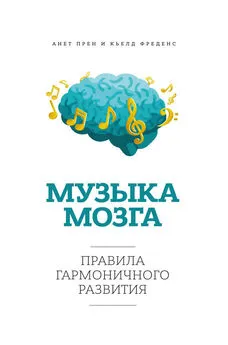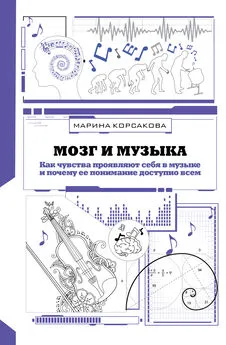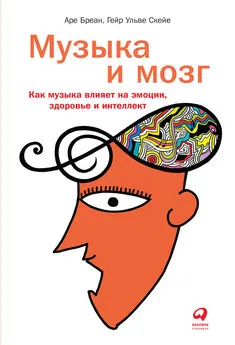Аре Бреан - Музыка и мозг [Как музыка влияет на эмоции, здоровье и интеллект]
- Название:Музыка и мозг [Как музыка влияет на эмоции, здоровье и интеллект]
- Автор:
- Жанр:
- Издательство:Альпина Паблишер
- Год:2020
- Город:Москва
- ISBN:978-5-9614-3287-9
- Рейтинг:
- Избранное:Добавить в избранное
-
Отзывы:
-
Ваша оценка:
Аре Бреан - Музыка и мозг [Как музыка влияет на эмоции, здоровье и интеллект] краткое содержание
Норвежские преподаватели нейробиологии музыки Аре Бреан и Гейр Ульве Скейе помогают заглянуть внутрь собственной головы и посмотреть, что там происходит, когда вы слушаете любимую песню.
Музыка и мозг [Как музыка влияет на эмоции, здоровье и интеллект] - читать онлайн бесплатно ознакомительный отрывок
Интервал:
Закладка:
Jourdain, R.: Music, the Brain, and Ecstasy — How music captures our imagination . William Morrow Paperbacks, 2008.
Tramo, M. J., Cariani, P. A., Delgutte, B. og Braida, L. D.: «Neuro-biological foundations for the theory of harmony in western tonal music». Annals of the New York Academy of Sciences , 2001; 930: 92–116.
Virtala, P., Huotilainen, M., Partanen, E., Fellman, V. og Tervaniemi, M.: «Newborn infants' auditory system is sensitive to Western music chord categories». Frontiers in Psychology 2013; 7: 492. doi: 10.3389/fpsyg.2013.00492.
Chatwin, B.: The songlines . Vintage books, Penguin Random House, London, 1987.
Hannon, E. E.: «Perceiving speech rhythm in music: listeners classify instrumental songs according to language of origin». Cognition 2009; 111: 404–10.
Канеман Д. Думай медленно… решай быстро. — М.: АСТ, 2014.
А. Лурия. Маленькая книжка о большой памяти (Ум мнемониста). — М.: Эйдос, 1994.
Patel, A. D., Iversen, J. R. og Rosenberg, J. C.: «Comparing the rhythm and melody of speech and music: the case of British English and French». The Journal of the Acoustical Society of America 2006; 119: 3034–47.
Shaw, J.: The Memory Illusion — Remembering, Forgetting, and the Science of False Memory . Random House Books, New York, 2017.
Soley et al.: «Infants prefer the musical meter of their own culture: A cross-cultural comparison». Developmental Psychology . 2010; 46: 286–292.
Steinbeis, N. og Koelsch, S.: «Understanding the intentions behind man-made products elicits neural activity in areas dedicated to mental state attribution». Cerebral Cortex 2009; 19: 619–23.
Vuust, P., Gebauer, L. K. og Witek, M. A.: «Neural underpinnings of music: the polyrhythmic brain». Advances in Experimental Medicine and Biology 2014; 829: 339–56.
Arjmand, H. A., Hohagen. J., Paton., B. og Rickard, N. S.: «Emotional Responses to Music: Shifts in Frontal Brain Asymmetry Mark Periods of Musical Change». Frontiers in Psychology 2017; 8: 2044.
Beaty, R. E.: «The neuroscience of musical improvisation». Neuroscience and biobehavioral reviews 2015; 51: 108–117.
Bode, S. og Hanxi, A. et al.: «Decisions using ultra-high field fMRI». PLOS One 2011; 6: e21612.
Curtis, M. E. og Bharucha, J. J.: «The minor third communicates sadness in speech, mirroring its use in music». Emotion 2010; 10: 335–48.
Damasio, A. R.: The feeling of what happens. Body and Emotion in the Making of Consciousness . Harcourt Brace & Company, New York, 1999.
Deutsch, D., North, T. og Ray, L.: «The tritone paradox: correlate with the listener's vocal range for speech». Music Perception 1990; 7: 371–384.
Juslin, P. N.: «From everyday emotions to aesthetic emotions: towards a unified theory of musical emotions». Physics of Life Reviews 2013; 10: 235–66.
Koelsch, S., Fritx, D. Y., Müller, K. og Friederici, A. D.: «Investigating emotion with music: an fMRI study». Human Brain Mapping 2006; 27: 239–250.
Limb, C. L. og Braun, A. R.: «Neural substrates of spontaneous musical performance. An fMRI study of jazz improvisation». PLOS One 2008; 3: e1679.
Patel, A. D., Iversen, J. R. og Rosenberg, J. C.: «Comparing the rhythm and melody of speech and music: the case of British English and French». The Journal of the Acoustical Society of America 2006; 119: 3034–47.
Pinho, A., de Manzano, Ö., Fransson, P., Eriksson, H. og Ullén, F.: «Connecting to create: expertise in musical improvisation is associated with increased functional connectivity between premotor and prefrontal areas». Journal of Neuroscience 2015; 34: 6156–6163.
Poon, M. og Schutz, M.: «Cueing musical emotions: An empirical analysis of 24-piece sets by Bach and Chopin documents parallels with emotional speech». Frontiers in Psychology 2015; 2; 6: 1419.
Pressing, J.: «Improvisation: methods and models». I: Sloboda, J. A. (red.): Generative Processes in Music: The Psychology of Performance, Improvisation, and Composition . Clarendon Press, Oxford, 1988.
Rizzolatti, G., Sinigaglia, C. og Anderson, F.: Mirrors in the brain: how our minds share actions and emotions . Oxford University Press, Oxford, 2008.
Sachs, M. E., Damasio, A. og Habibi, A.: «The pleasures of sad music: a systematic review». Frontiers in Human Neuroscience 2015; 9: 404.
Shoemark, H., Hanson-Abromeit, D. og Stewart, L.: «Constructing optimal experience for the hospitalized newborn through neuro-based music therapy». Frontiers in Human Neuroscience 2015; 9: 487.
Trehub, S.E, Ghazban, N. og Corbeil, M.: «Musical affect regulation in infancy». Annals of the New York Academy of Sciences 2015; 1337: 186–92.
Trondalen, G. og Oveland, S.: «The Bonny Method of Guide Imagery and Music (BMGIM)». I: Trondalen, G. og Ruud, E.: Perspektiver på musikk og helse. 30 år med norsk musikkterapi . Skriftserie fra Senter for musikk og helse. NMH-publikasjoner, 2008: 3.
Chaudhury, S., Sharma, V. og Kumar, V. et al.: «Activity-dependent synaptic plasticity modulates the critical phase of brain development». Brain and Development 2016; 38: 355–63.
Kempermann, G., Gage, F. H. og Aigner, L. et al.: «Human Adult Neurogenesis: Evidence and Remaining Questions». Cell Stem Cell . 2018; 23: 25–30.
Kim, S. G. og Knösche, T. R.: «On the Perceptual Subprocess of Absolute Pitch». Frontiers in Neuroscience 2017; 11: 557. doi: 10.3389/fnins.2017.00557.
Merzenich, M. M., Van Vleet, T. M. og Nahum, M.: «Brain plasticity-based therapeutics». Frontiers in Human Neuroscience 2014; 8: 385. doi: 10.3389/fnhum.2014.00385.
Darold, A. T.: «The savant syndrome: an extraordinary condition. A synopsis: past, present, future». Philosophical Transactions of the Royal Society B: Biological Sciences 2009; 364: 1351–1357.
Haueisen, J. og Knösche, T. R.: «Involuntary motor activity in pianists evoked by music perception». Journal of Cognitive Neuroscience 2001;13:786–92.
Howe, M. J. A., Davidson, J. W., Sloboda, J. A.: «Innate talents: reality or myth?» Behavioral and Brain Sciences 1998; 21: 399–407.
Krings, T. et al.: «Cortical activation patterns during complex motor tasks in piano players and control subjects. A functional magnetic resonance imaging study». Neuroscience Letters 2000; 278: 189–193.
Lahav, A., Saltzman, E., Schlaug, G. et al.: «Action representation of sound: audiomotor recognition network while listening to newly acquired actions». Journal of Neuroscience 2007; 27: 308–314.
Levitin, D.: This is your brain on music: The science of a human obsession . Dutton, New York, 2006.
Münte, T. F., Altenmüller, E. og Jäncke, L.: «The musician's brain as a model of neuroplasticity». Nature Reviews Neuroscience 2002; 3: 473–478.
Robertson, P.: «What is musical genius?» Clinical Medicine ; London 2008; 8: 178–181.
Stewart, L., Henson, R., Kampe, K. et al.: «Brain changes after learning to read and play music». NeuroImage 2003; 20: 71–83.
Swaminathan, S. og Schellenberg, E. G.: «Musical Competence is Predicted by Music Training, Cognitive Abilities, and Personality». Scientific Reports 2018; 8: 9223.
Vines, B. W., Krumhansl, C. L., Wanderley, M. M. et al.: «Music to my eyes: cross-modal interactions in the perception of emotions in musical performance». Cognition 2011;118:157–70.
Ericsson, A. K., Prietula, M. J., Cokely, E. T.: «The Making of an Expert». Harvard Business Review 2007.
Maguire, E. A., Gadian, D. G. og Johnsrude, I. S.: «Navigation-related structural change in the hippocampi of taxi drivers». Proceedings of the National Academy of Sciences of the United States of America 2000; 97: 4398–4403.
Schlaug, G.: «Musicians and music making as a model for the study of brain plasticity». Progress in Brain Research 2015; 217: 37–55.
Schlaug, G.: «The brain of musicians». I Peretz, I. og Zatorre, R.: The cognitive neuroscience of music . Oxford University Press, Oxford, 2009.
Steele, C. J., Bailey, J. A. og Zatorre, R. J. et al.: «Early Musical Training and White-Matter Plasticity in the Corpus Callosum: Evidence for a Sensitive Period». Journal of Neuroscience 2013; 33: 1282–1290.
Balbag, M. A., Pedersen, N. L. og Gatz, M.: «Playing a Musical Instrument as a Protective Factor against Dementia and Cognitive Impairment: A Population-Based Twin Study». International Journal of Alzheimer's Disease 2014; 2014: 836748.
Costa-Giomo, E.: «The Effects of Three Years of Piano Instruction on Children's Cognitive Development». Journal of Research in Music Education 1999.
Dumont, E., Syurina, E. V., Feron, F. J. M. og van Hooren, S.: «Music Interventions and Child Development: A Critical Review and Further Directions». Frontiers in Psychology 2017; 8: 1694.
Hanna-Pladdy, B. og MacKay, A.: «The relation between instrumental musical activity and cognitive aging». Neuropsychology 2011; 25: 378–86.
Hassler, M., Birbaumer, N. og Feil, A.: «Musical Talent and Visual-Spatial Abilities: A Longitudinal Study». Psychology of Music 1985; 13: 99–113.
Jaschke, A. C., Honing, H. og Scherder, E. J. A.: «Longitudinal Analysis of Music Education on Executive Functions in Primary School Children». Frontiers in Neuroscience 2018; 12: 103.
Kraus, N., Slater, J. og Thompson, E. C. et al.: «Music enrichment programs improve the neural encoding of speech in at-risk children». Journal of Neuroscience 2014; 34: 11913–8.
Moreno, S., Bialystok, E., Barac, R. et al.: «Short-term music training enhances verbal intelligence and executive function». Psychological Science 2011; 22: 1425–33.
Nantais, K. M. og Schellenberg, E. G.: «The Mozart effect: An artefact of preference». Psychological Science 1999; 10: 370–373.
Patel, A. D.: «Why would Musical Training Benefit the Neural Encoding of Speech? The OPERA Hypothesis». Frontiers in Psychology 2011; 2: 142.
Rauscher, F. H., Shaw, G. L., Ky, K. N.: «Music and spatial task performance». Nature 1993; 365: 611.
Roden, I., Kreutz, G. og Bongard, S.: «Effects of a school-based instrumental music program on verbal and visual memory in primary school children: a longitudinal study». Frontiers in Psychology 2012; 3: 572.
Rogenmoser, L., Kernbach, J., Schlaug, G. og Gaser, C.: «Keeping brains young with making music». Brain Structure & Function 2018;223:297–305.
Schellenberg, E. G.: «Does exposure to music have beneficial side effects?» I Peretz, I. og Zatorre, R.: The cognitive neuroscience of music . Oxford University Press, New York, 2009.
Strait, D. L., Kraus, N., Skoe, E. og Ashley, R.: «Musical experience and neural efficiency: effects of training on subcortical processing of vocal expressions of emotion». European Journal of Neuroscience 2009; 29: 661–8.
Читать дальшеИнтервал:
Закладка:
![Обложка книги Аре Бреан - Музыка и мозг [Как музыка влияет на эмоции, здоровье и интеллект]](/books/1068692/are-brean-muzyka-i-mozg-kak-muzyka-vliyaet-na-emoc.webp)









